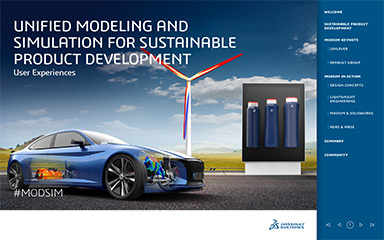Latest News
September 16, 2019
With the new release of ANSYS Autonomy, part of ANSYS 2019 R3, ANSYS enables engineers to develop safer autonomous vehicles (AVs) through advanced closed-loop scenario simulation; automated driving and control software development; functional safety analysis; and sensor, camera, lidar and radar simulation.
“In ANSYS 2019 R3, ANSYS Autonomy integrates ANSYS flagship products into a comprehensive virtual testing and development environment for AVs,” says Eric Bantegnie, vice president and general manager, systems business unit at ANSYS.
ANSYS 2019 R3 extends the ANSYS SCADE family of products with the launch of ANSYS SCADE Vision. ANSYS SCADE Vision reduces the cost of AV perception software testing, enhances safety and drives value from AV data.
ANSYS SCADE Suite enhances features required for developing advanced automotive systems and the embedded software that controls these systems for autonomous vehicles. ANSYS 2019 R3 includes improved AUTOSAR support in SCADE for ISO 26262 certified code generation and software component design.
ANSYS 2019 R3 includes multiple tool enhancements to ANSYS VRXPERIENCE Driving Simulator powered by SCANeR, ANSYS VRXPERIENCE HMI, ANSYS SPEOS and ANSYS HFSS SBR+.
Updates to ANSYS VRXPERIENCE provide innovations in scenario simulation, sensors, sound simulations and virtual reality (VR); the software also offers SPEOS Live Preview. ANSYS VRXPERIENCE HMI now allows users to run and interact with embedded software in VR as a software-in-the-loop model.
While ANSYS SPEOS continues to extend optical simulation into ANSYS’ Multiphysics platform, SPEOS Live Preview helps designers accelerate their design innovation thanks to GPU acceleration. ANSYS 2019 R3 also includes the SPEOS Road Library for Sensors Simulation, a retro-reflecting materials database.
In ANSYS 2019 R3, ANSYS electromagnetics suite includes new features for engineers tackling complex autonomous vehicle engineering challenges. ANSYS HFSS SBR+ now includes creeping wave physics that delivers greater accuracy for predicting radar cross section (RCS) of large targets with curvatures.
ANSYS also introduces ANSYS Minerva. Powered by Aras, ANSYS Minerva is a knowledge management product for critical simulation expertise. ANSYS Minerva improves productivity and maximizes business value from existing engineering technology investments by providing model-based system engineering, simulation process and data management, lifecycle traceability, process integration, design optimization and simulation-driven data science capabilities.
The ANSYS semiconductor portfolio of power efficiency, power integrity and reliability solutions achieve ISO 26262 certifications to enable automotive integrated circuit designers to meet safety requirements for AV applications. Auto chip makers can leverage ANSYS PowerArtist, the ANSYS RedHawk family and ANSYS Totem multiphysics simulations for all ISO 26262 safety-related projects for any ASIL level.
Beyond ANSYS Autonomy, additional enhancements to the ANSYS product portfolio in ANSYS 2019 R3 include:
Simplified Workflows in Flagship Products
ANSYS Mechanical features the full integration of ANSYS Motion, the addition of Sherlock Automated Design Analysis Software and the new coupled field analysis systems.
With this latest release, ANSYS Cloud incorporates on-demand computing within more applications in the ANSYS product portfolio. Building upon existing support for structures, fluids and high frequency simulation tools, ANSYS Maxwell and Q3D Extractor can now easily submit jobs to secure high-performance compute infrastructure on Microsoft Azure.
The launch of Distributed Compute Services (DCS), a new family of applications, enables users to distribute, manage and solve simulations on a variety of compute resources. DCS empowers users to more effectively use compute resources across operating systems, networks and locations.
In the Fluids suite, ANSYS Fluent has a new user experience that enables engineers to complete more computational fluid dynamics simulations in less time and with less training.
Additionally, in ANSYS 2019 R3, a new automated workflow speeds the ANSYS Fluent adjoint solver so users can easily find the optimal shape for given operating conditions.
Faster Problem Solving Across Product Portfolio
In ANSYS 2019 R3, the Discovery family introduces generative design capabilities through the first interactive topology optimization tool with speed and ease of use that finds optimal designs in minutes.
In ANSYS 2019 R3, ANSYS Multiphysics can now simulate electro-thermal management problems, such as those seen in motors and busbars, to include cases with 3D transient ANSYS Maxwell analyses. Performance and accuracy are also improved—testing on industrial strength cases demonstrates a 15% speedup of system coupling and faster co-simulation than previous releases.
With ANSYS medini analyze, ANSYS extends its functional safety analysis expertise beyond automotive and aerospace to industrial equipment with a new safety domain profile for industrial applications according to IEC 61508 in medini.
In the Additive suite, ANSYS Additive family improves capabilities across all products to simplify workflows, enable multiple supports and support removal.
The new release of GRANTA Materials Data for Simulation provides easy access to additional material property data, now embedded within ANSYS Electronics Desktop as well as ANSYS Mechanical. ANSYS 2019 R3 also introduces ANSYS GRANTA Selector, a renamed update to CES Selector.
Sources: Press materials received from the company and additional information gleaned from the company’s website.
More Ansys Coverage
Subscribe to our FREE magazine, FREE email newsletters or both!
Latest News
About the Author
DE’s editors contribute news and new product announcements to Digital Engineering.
Press releases may be sent to them via DE-Editors@digitaleng.news.






